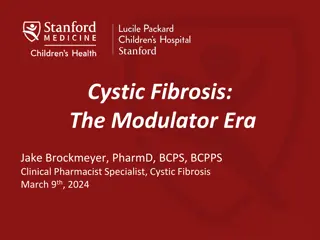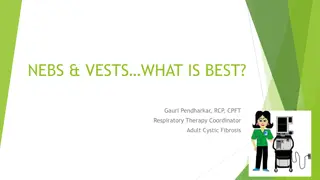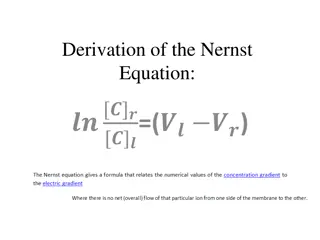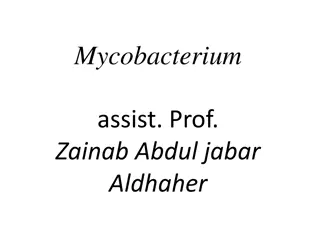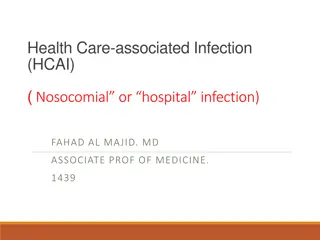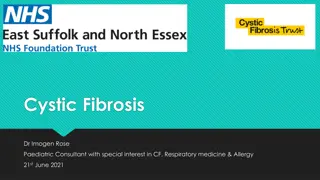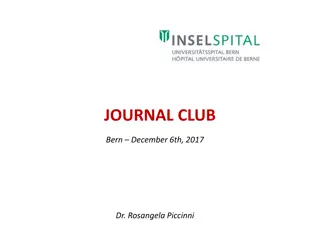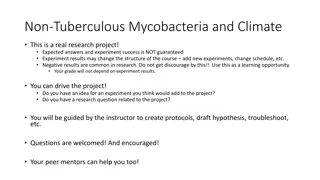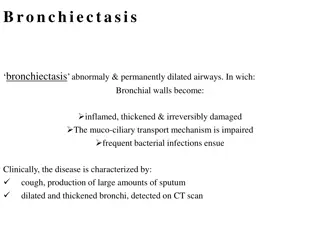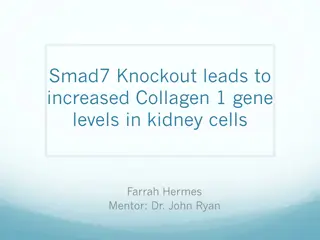Understanding Nontuberculous Mycobacteria Infections in Cystic Fibrosis
Nontuberculous mycobacteria (NTM) infections present a significant challenge in individuals with cystic fibrosis (CF). These infections are caused by over 200 species of atypical mycobacteria found in various environments. The CF-ID Clinic plays a crucial role in managing patients with multi-drug resistant bacteria or fungal infections, including refractory conditions like Allergic Bronchopulmonary Aspergillosis. Risk factors for NTM infections include increased age, adult CF diagnosis, Aspergillus on sputum cultures, and corticosteroid use. Recent data highlights the rising incidence of NTM isolation in CF patients, emphasizing the need for vigilance in diagnosis and treatment.
Download Presentation

Please find below an Image/Link to download the presentation.
The content on the website is provided AS IS for your information and personal use only. It may not be sold, licensed, or shared on other websites without obtaining consent from the author. Download presentation by click this link. If you encounter any issues during the download, it is possible that the publisher has removed the file from their server.
E N D
Presentation Transcript
Nontuberculous Mycobacteria Infections in CF March 9, 2024 Joanna Nelson MD Clinical Assistant Professor Infectious Disease
Microbes in Cystic Fibrosis Viruses: Influenza RSV Parainfluenzae COVID low risk Bacteria: Staph aureus Pseudomonas Achromobacter Stenotrophomonas Burkholderia Non-tuberculosis mycobacteria some risk high risk Fungi: Aspergillus Scedosporium
CF-ID Clinic low risk Every other Thursday afternoon some risk high risk How can ID help?? Multi-drug resistant bacteria or patients with limited treatment options Fungal infections Refractory Allergic Bronchopulmonary Aspergillosis Atypical bacteria including Non-tuberculous mycobacteria
Nontuberculous mycobacteria (NTM) Atypical mycobacteria Over 200 species now described Found throughout the environment
Nontuberculous mycobacteria (NTM) Syndrome Most Less Frequent Cause Common Cause Chronic MAC, M. xenopi, M. malmoense, M. szulgai, M. smegmatis, M. celatum, M. simiae, M. goodii, M. asiaticum, M. heckeshomense, M. branderi, M. lentiflavum, M. triplex, M. fortuitum, M. arupense, M. phocaicum, M. aubagnense, M. florentinum, M. nebraskense, M. saskatchewanense, M. seolense, M. senuense, M. parasoeulense, M. europaeum, M. sherrisii, M. kyronense, M. noviomagense, M. mantenii, M. shinjukuense, M. koreense, M. heraklionense, M. parascrofulaceum, M. arosiense nodular disease (adults with bronchiectasis, CF) M.abscessus, M.kansasii Gordin FM, Horsburgh CR. Mandell Principles and Practice of Infectious Disease, 253: 2832-43
Incidence of NTM Culture Positivity Data from 2010-2019 CFF Registry shows annual increase in NTM isolation in CF patients Most common species: Mycobacterium avian complex (MAC and Mycobacterium abscessus (MAB) Marshall et al. BMC Infectious Diseases 2023; 23:489.
More Recent Data: Era of HEMT 2022 report: 10.3% had NTM isolated 1 or more times Martiniano SL et al, Clin Chest Med 2022; 43 (4): 697-716; CFF Registry Annual Report 2022, cff.org
Risk Factors Increased age Adult diagnosis of CF Aspergillus on sputum cultures/ABPA Corticosteroid use (oral or inhaled) Isolation of another NTM species Non-CF populations: gastro-esophageal reflux, low BMI, low Vitamin D levels No clear association with: Azithromycin use, isolation of various bacterial pathogens Floto RA, Olivier KN, Saiman L, et al Thorax 2016; 71:i1-i22.
Guidelines Patients with stable clinical course should have annual screening for NTM with acid fast bacilli (AFB) cultures from expectorated sputum
Microbiology process Smear - rapid, assess for high burden Liquid media - higher yield, faster Solid media - visualize morphology, growth rate, quantification Identification by molecular techniques
Significance of Positive culture 21% 40% 39% Martiniano SL et al. Ann Am Thorac Soc 2014 11(1):36-44.
Definition of NTM Pulmonary Disease Clinical Criteria: -Shortness of breath, cough -Declining PFTs -Fatigue, Malaise -Fever, night sweats -Weight loss *Exclusion of other diagnoses Microbiologic Criteria -Positive culture from at least 2 separate expectorated sputum samples -Positive culture from one bronchoalveolar lavage Radiographic Criteria: -Bronchonodular disease -Fibrocavitary disease Griffith DE et al, Am J Respir Crit Care Med 2007; 175(4): 367-416.;Floto RA et al, Thorax 2016; 71 Suppl 1i1-22.
Definition of NTM Pulmonary Disease in CF Clinical and radiographic unexplained loss in lung function Increased respiratory symptoms Fever, fatigue, night sweats, weight loss Progression of radiographic features consistent with NTM infection Exclusion of other comorbidities co-infections with other bacteria (Staph aureus, Pseudomonas) Airway clearance therapy Nutritional deficiencies ABPA CF sinus disease CF related Diabetes
Clinical Impact of NTM Pulmonary Disease Qvist T et al, J Cyst Fibros 2016; 15:380-5.
Consideration for treatment Meet criteria for NTM Pulmonary disease Individualized decision regarding risks and benefits Medication side effects Lung function (? transplant candidate) Treatment goals: culture conversion/eradication symptom relief radiographic improvement
Treatment Principles Multiple drug regimen (usually at least 3 active drugs) Drug susceptibilities are not always predictive of treatment outcome Aim for 12 months of treatment from the time of clearance of cultures Close monitoring for side effects
MAC Treatment Azithromycin Ethambutol +/- Rifampin (interactions HEMT) May be replaced with another agent +/- IV amikacin for first 1-3 months smear positive severely ill cavitary disease Oral therapy should be given daily. Azithromycin mono-therapy should be avoided!! Floto RA et al, Thorax 2016; 71 Suppl 1i1-22.
Outcomes - MAC Treatment success (microbiologic clearance) in 60% of patients Median time to clearance 4 months Recurrence rates up to 40% at 3 years Failure associated with previous MAC treatment, cavitary disease, smear positivity, clarithromycin/azithromycin resistance Kwak N et al, CID 2017 Jun 3
Mycobacterium abscessus Treatment Approach Functional erm gene = Azithromycin Resistant No Yes Amikacin (IV) IV Cefoxitin or Imipenem IV Tigecycline* Azithromycin + IV Cefoxitin or Imipenem IV Amikacin Induction Phase: 12 weeks *Alternatives: Tedizolid, Linezolid Clofazimine Bedaquiline Omadacycline Amikacin (IH) Cefoxitin or Imi Oral Agent* Azithromycin Amikacin IH Oral agent* Maintenance Phase: Through 12 months after cx clearance Floto RA et al, Thorax 2016; 71 Suppl 1i1-22.
Mycobacterium abscessus Outcomes M.a.abscessus (Azithro R) M.a .massiliense (Azithro S) p Value 75% 97% 0.040 Symptomatic Improvement 42% 82% 0.003 Radiographic Improvement 25% 88% <0.001 Culture Conversion Koh WJ et al, Am J Respir Crit Care Med 2011; 183(3):405-10.
Monitoring on therapy Monitor for toxicity of antibiotics: Periodic Labs to assess for drug toxicities Periodic ophthalmology exam (every 6 months) if on ethambutol Audiology exams if on IV or IH amikacin Monitor for response to therapy: Sputum AFB cultures every 1-2 months Assess for clearance at 4-6 months If fail to clear: repeat susceptibilities, consider drug levels, consider additional agents, or consider changing treatment goals Richards CJ, Olivier KN. Semin Respir Crit Care Med 2019; 40(06):737-750.
Prevention 1. Reduce NTM aerosols in showers by opening a window in the bathroom and ensuring plenty of ventilation. 2. Avoid using saunas, showers, hot tubs or any water with an aerator. 3. Avoid humidifiers if possible. 4. Clean your showerhead regularly. Remove the showerhead and disassemble it to the best of your ability. Place it in soapy water and scrub all the surfaces. 5. Clean taps to prevent biofilm buildup. Use a cotton swab or wash cloth and twist it around to scrub the interior surface. NTMinfo.org
Prevention 1. Reduce your exposure to dusts from potting soils. Keep the potting soil moist, so when you handle it there is no dust, and wear an inexpensive mask to keep out the dust particles. A good mask for this is an N-95 mask, which can be purchased at hardware stores or online. 2. Place in-line filters in showers and water taps to collect NTM and reduce NTM numbers passing filter. However, filters need to be changed every 3 weeks. 3. Raise the temperature of your water heater to 55 C (131 F) which can help inhibit growth of NTM. Be careful because the temperature is high enough to scald. 4. Take steps to reduce GERD. NTMinfo.org
Future Directions Better understanding of HEMT impact on NTM colonization and disease in CF Treatment data in CF population: PATIENCE Trial (NCT02419989)





